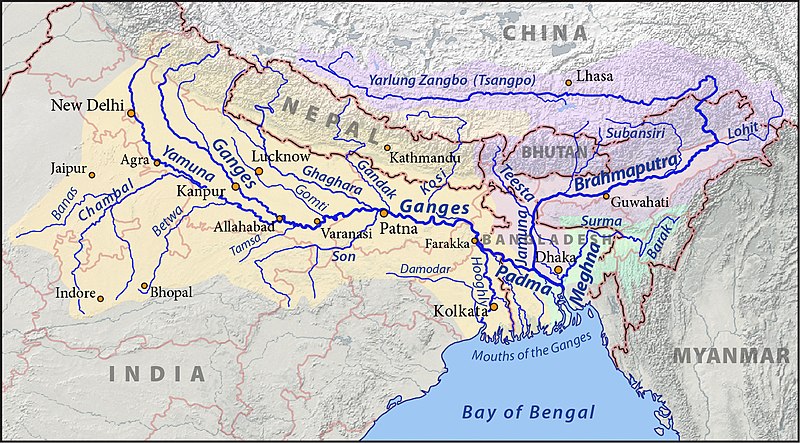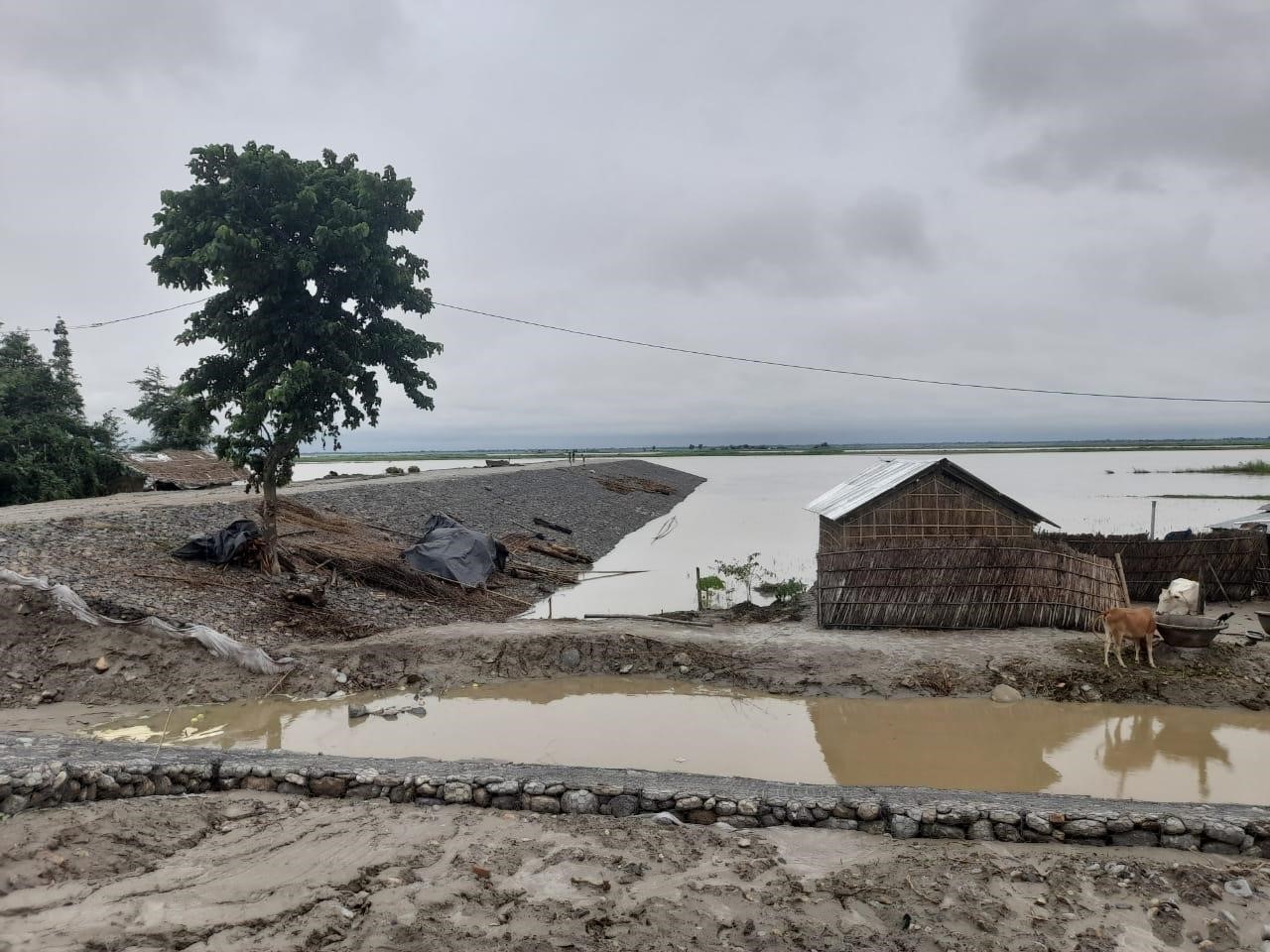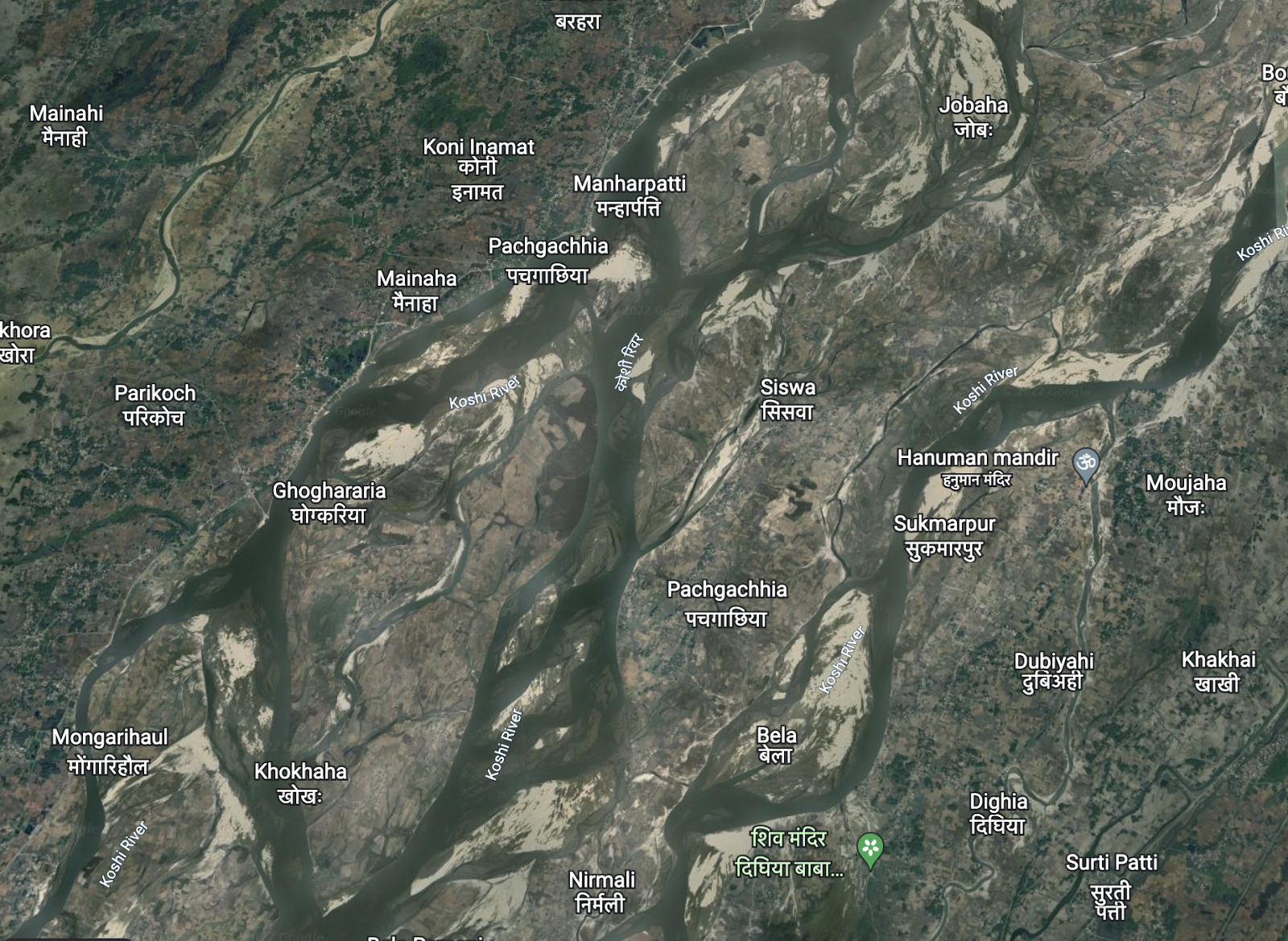Challenges of flood control technologies on Kosi River in India
Kaniska Singh09/04/2023 | Reflections
Kosi is a transboundary river flowing through Tibet, Nepal and India. It is one of the most meandering and silt-laden rivers worldwide. It has a long history of floods and an equally long history of flood control through colonial structural solutions. Some such structural solutions are embankments, barrages, safety dams, ring bunds, spurs, and porcupines. This blog discusses the ambivalence associated with such structures on the Kosi River, particularly embankments. Embankments are technological structures inhibiting the river to a specific width termed as an ‘unprotected’ region, thus making the area beyond this zone ‘protected’, safer and habitable.

Map showing the basins of Ganges, Brahmaputra and Meghna rivers in South Asia. It shows the geographical span of the Kosi River. [Image credit: “Ganges-Brahmaputra-Meghna basins” by Pfly CC BY-SA 3.0]
With the growing threat of climate-change-induced floods, restoring natural river floodplains has become a vital climate adaptation strategy worldwide. Yet, neither this narrative nor the corresponding solutions to address flood risks have any popular support along the Kosi River. On the contrary, despite their risks, the local demand for embankments and other technological structures to control floods continues to rise.
This demand may seem counterintuitive and maladaptive. However, it needs to be understood in relation to the sociotechnical imaginaries associated with embankments and other structural solutions. Alluding to these imaginaries, this blog discusses the challenges of inhabiting the unprotected river islands of the Kosi River in the Bihar state of India. It highlights the entanglements of these structures with local politics.
The embankments from the eyes of the unprotected
Many riverine communities engaged in agriculture and river-based livelihood across South Asian countries have lived with riverine floods for more than 300 years. Over time, they have learnt to deal with the monsoon overflow of the river channels. However, their experiences of living with floods have been reconfigured through flood-control structures.

One of the embankments on Kosi River’s eastern banks and a house in an unprotected region [Image credit: Kaniska Singh]
This demand may seem counterintuitive and maladaptive. However, it needs to be understood in relation to the sociotechnical imaginaries associated with embankments and other structural solutions. Alluding to these imaginaries, this blog discusses the challenges of inhabiting the unprotected river islands of the Kosi River in the Bihar state of India. It highlights the entanglements of these structures with local politics.
The embankments from the eyes of the unprotected
Many riverine communities engaged in agriculture and river-based livelihood across South Asian countries have lived with riverine floods for more than 300 years. Over time, they have learnt to deal with the monsoon overflow of the river channels. However, their experiences of living with floods have been reconfigured through flood-control structures.

One of the embankments on Kosi River’s eastern banks and a house in an unprotected region [Image credit: Kaniska Singh]
Living with floods and embankments
The uncertain patterns of riverbank erosion, colloquially known to the inhabitants of unprotected regions as “kataniya” (in the Thethi dialect of the Maithili language), keep these communities at the edge. Due to this uncertain riverbank erosion, they have to adapt to multiple relocations within their lifetimes and increasingly uncertain agriculture. The changed flooding patterns have rendered fishing challenging, pushing fishing communities to turn to agriculture for subsistence. Additionally, inhabitants of the unprotected regions lack year-round access and provisioning to basic public amenities like education, health, roads, and permanent settlements.
Local communities problematise the shifting cartography of unprotected regions due to regular riverbank erosion and accretion triggered. Lands, at times, remain uncultivable due to prolonged submergence under river channels. The transboundary nature of the Kosi River further complicates these challenges. Poor flood-related communication between the upstream Kosi barrage in Nepal and downstream villages in Bihar threatens people’s local estimation of rainfall and flooding. The downstream communities claim that the construction of routine flood control activities in the upstream region has rendered the downstream riverbanks more vulnerable to kataniya.
The embankments redistribute the flood water to unprotected regions. The apparent challenges are multiple relocations, growing agricultural uncertainty, lack of basic public amenities, and epistemic threats to local communities.

Some of the villages located in a stretch of the unprotected region between two embankments along the length of the Kosi River in Bihar [Image source: Google Earth]
The uncertain patterns of riverbank erosion, colloquially known to the inhabitants of unprotected regions as “kataniya” (in the Thethi dialect of the Maithili language), keep these communities at the edge. Due to this uncertain riverbank erosion, they have to adapt to multiple relocations within their lifetimes and increasingly uncertain agriculture. The changed flooding patterns have rendered fishing challenging, pushing fishing communities to turn to agriculture for subsistence. Additionally, inhabitants of the unprotected regions lack year-round access and provisioning to basic public amenities like education, health, roads, and permanent settlements.
Local communities problematise the shifting cartography of unprotected regions due to regular riverbank erosion and accretion triggered. Lands, at times, remain uncultivable due to prolonged submergence under river channels. The transboundary nature of the Kosi River further complicates these challenges. Poor flood-related communication between the upstream Kosi barrage in Nepal and downstream villages in Bihar threatens people’s local estimation of rainfall and flooding. The downstream communities claim that the construction of routine flood control activities in the upstream region has rendered the downstream riverbanks more vulnerable to kataniya.
The embankments redistribute the flood water to unprotected regions. The apparent challenges are multiple relocations, growing agricultural uncertainty, lack of basic public amenities, and epistemic threats to local communities.

Some of the villages located in a stretch of the unprotected region between two embankments along the length of the Kosi River in Bihar [Image source: Google Earth]
Demands for protection and embankments:
Despite the highlighted challenges, people inhabiting unprotected regions on the Kosi Riverplain demand the construction of more embankments. The demand for other structural solutions, such as safety dams, ring bunds, and roads, is also rising among local communities.
Over the years, many villages in unprotected regions on the Kosi riverplain have employed political patronage or community-led funding to construct small safety dams, bunds, and embankments. In local-level politics, flood-control structures are electoral artefacts that promise the protection of habitations and croplands and, thus, development.
The demand for rehabilitation and resettlement is widespread too. Annually, with the riverbank erosion intensifying in the monsoon season, families migrate seasonally or permanently to better-protected regions. However, those unable to rehabilitate are left in the lurch. The most affected are those with little to no economic and social capital in a region protected against floods. Such people are compelled to live with floods without reliable state support and alternative housing arrangements. For such households, the embankments and other structural solutions offer instant respite in the form of short- and long-term shelters from the floodwaters and the uncertain erosion. Additionally, these strategically located structural solutions allow small farmers to grow crops on lands adjacent to them.
Once consciously deciding to stay back, the meaning of ‘living with floods’ is sharply questioned by the existing generation of inhabitants. They are mired in the trade-off between risk-taking and making a living in these liminal spaces. Their demands for technological structures emerge from their experiences living with floods – regular riverbank erosions and inundations.
However, even with the structural solutions, the primary beneficiaries are the landholders. The more vulnerable landless families will likely be evicted from the newly protected lands owing to a lack of land ownership documents, increased land prices, and agricultural productivity.
This incongruity reflected in the demand for new structures and the problematisation of the existing ones points to the complexity of communities’ relationships with embankment-like structures. People hold these structural solutions responsible for exacerbating their uncertainty and challenges due to floods. However, their critique has shifted from being epistemological to being only about the location of these structures.
Conclusion
The embankments and other technological structures of flood control embody the risk of and protection from floods within the narratives of communities affected by floods in the Kosi River. The sociotechnical imaginaries associated with these structures comprise a future free of erosion, improved economic conditions, and improved access to education and health. However, the simultaneous demand for resettlement reflects the arduous relationship between the river and the nearby population, where the local knowledge of living with floods is slowly becoming redundant. Communities’ ambivalent relationship with, and demand for, these flood control structures must be understood through the frame of both the experiences and the plans, between daily lives and emergencies, in a changing landscape. Living with floods remains acutely perilous as long as the technological structures dominate flood governance. The non-structural solutions to flood control, such as floodplain zoning, watershed management and forecasting, remain on paper, bereft of any meaningful state interventions.
Kaniska Singh is a PhD student at the Ashank Desai Centre for Policy Studies at the Indian Institute of Technology (IIT) Bombay, Mumbai. As part of her PhD project, she is investigating the role of flood governance and policy process in producing flood vulnerability in the Kosi riverplains in Bihar, India. She is also interested in disaster justice to understand the production of vulnerability.
Despite the highlighted challenges, people inhabiting unprotected regions on the Kosi Riverplain demand the construction of more embankments. The demand for other structural solutions, such as safety dams, ring bunds, and roads, is also rising among local communities.
Over the years, many villages in unprotected regions on the Kosi riverplain have employed political patronage or community-led funding to construct small safety dams, bunds, and embankments. In local-level politics, flood-control structures are electoral artefacts that promise the protection of habitations and croplands and, thus, development.
The demand for rehabilitation and resettlement is widespread too. Annually, with the riverbank erosion intensifying in the monsoon season, families migrate seasonally or permanently to better-protected regions. However, those unable to rehabilitate are left in the lurch. The most affected are those with little to no economic and social capital in a region protected against floods. Such people are compelled to live with floods without reliable state support and alternative housing arrangements. For such households, the embankments and other structural solutions offer instant respite in the form of short- and long-term shelters from the floodwaters and the uncertain erosion. Additionally, these strategically located structural solutions allow small farmers to grow crops on lands adjacent to them.
Once consciously deciding to stay back, the meaning of ‘living with floods’ is sharply questioned by the existing generation of inhabitants. They are mired in the trade-off between risk-taking and making a living in these liminal spaces. Their demands for technological structures emerge from their experiences living with floods – regular riverbank erosions and inundations.
However, even with the structural solutions, the primary beneficiaries are the landholders. The more vulnerable landless families will likely be evicted from the newly protected lands owing to a lack of land ownership documents, increased land prices, and agricultural productivity.
This incongruity reflected in the demand for new structures and the problematisation of the existing ones points to the complexity of communities’ relationships with embankment-like structures. People hold these structural solutions responsible for exacerbating their uncertainty and challenges due to floods. However, their critique has shifted from being epistemological to being only about the location of these structures.
Conclusion
The embankments and other technological structures of flood control embody the risk of and protection from floods within the narratives of communities affected by floods in the Kosi River. The sociotechnical imaginaries associated with these structures comprise a future free of erosion, improved economic conditions, and improved access to education and health. However, the simultaneous demand for resettlement reflects the arduous relationship between the river and the nearby population, where the local knowledge of living with floods is slowly becoming redundant. Communities’ ambivalent relationship with, and demand for, these flood control structures must be understood through the frame of both the experiences and the plans, between daily lives and emergencies, in a changing landscape. Living with floods remains acutely perilous as long as the technological structures dominate flood governance. The non-structural solutions to flood control, such as floodplain zoning, watershed management and forecasting, remain on paper, bereft of any meaningful state interventions.
Kaniska Singh is a PhD student at the Ashank Desai Centre for Policy Studies at the Indian Institute of Technology (IIT) Bombay, Mumbai. As part of her PhD project, she is investigating the role of flood governance and policy process in producing flood vulnerability in the Kosi riverplains in Bihar, India. She is also interested in disaster justice to understand the production of vulnerability.
Published: 09/04/2023
